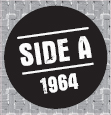
NOT FADE AWAY
Charles Hardin / Norman Petty / 1:48
SINGLE
Not Fade Away / Little by Little*
RELEASE DATE
United Kingdom: February 21, 1964
Label: Decca
RECORD NUMBER: DECCA F 11845
Musicians
Mick Jagger: vocals, hand claps, tambourine, maracas
Keith Richards: 12-string acoustic guitar, guitar solo
Brian Jones: harmonica
Bill Wyman: bass
Charlie Watts: drums
Recorded
Regent Sound Studios: January 10, 1964 (January 28 and February 4, according to some sources)
Technical Team
Producer: Andrew Loog Oldham
Sound Engineer: Bill Farley
Genesis
Recorded by Buddy Holly at the Norman Petty Studios in Clovis, New Mexico, on May 27, 1957, “Not Fade Away” was released the following October as the B-side of his single “Oh, Boy!” The song takes its rhythm from Bo Diddley—the logically named “Bo Diddley Beat,” or “Bo Diddley Sound”—that is a modern version of African American religious chants, the shouts that had their origins in the folk culture of West Africa. There is also a certain rhythmic affinity with the Cuban dance known as the habanera. A syncopated, hypnotic rhythm that corresponds perfectly to the idea of a love that “never dies.”
Although a cover, Andrew Loog Oldham has always considered “Not Fade Away” to be a Rolling Stones song, indeed the first by the Jagger-Richards songwriting partnership, for their arrangement. The A-side of their third single in the United Kingdom (with “Little by Little” as the B-side), “Not Fade Away” reached number 3 on the UK charts on February 27, 1964. It also opens side one of the American LP The Rolling Stones, England’s Newest Hit Makers (displacing “Mona,” track four on the British LP), which was released in April 1964.
Production
After listening to the Buddy Holly recording, Keith Richards immediately saw that “Not Fade Away” fit the Stones’ repertoire perfectly and that he would be able to transcend the original with a more aggressive, more accentuated riff. In truth, however, the person who really identified the number as a potential next single for the group was none other than Oldham himself. He explains in his memoirs: “[I] found Keith exactly where I’d left him that morning—fag in mouth, guitar on knee, singing bits of Buddy Holly’s ‘Not Fade Away.’”5 Suddenly, hearing Keith incorporate a riff that was far more “Bo Diddley” than anything on the original version, things fell into place for Oldham: “I heard our next record. I could actually hear the record in the room. The way he played it—you could hear the whole record. It was less pop more rock. It was a magical moment for me.”5
The recording took place at Regent Sound Studios on January 10. Other dates have also been mentioned by various sources, such as January 28 and February 4, when Phil Spector was present in the studio, but neither of these is confirmed by Bill Wyman, least of all the second: “It’s often said that we recorded ‘Not Fade Away’ at this session, with Phil Spector playing maracas, but Andrew used this as publicity, although he was more impressed than the media were.”1
According to Oldham, the take used as the basis for overdubbing took just twenty-five minutes. Keith, who had played the song numerous times at the apartment he shared with Mick and Oldham in Willesden, launches into the introduction on his Harmony 1270 12-string acoustic. The result is instant magic, providing a glimpse of the art of the riff that Richards would continue to hone throughout his career. Bill answers almost immediately with an E on his bass (at 0:05), which is the group’s signal. The machine lurches into action, and it could be said that “Not Fade Away” defines the true sound of the Rolling Stones for the very first time: the energy, the aggression, and the sensuality. Their version is far superior to Buddy Holly’s; the five English boys take hold of the number and give it an irresistible drive. Bill Wyman: “Buddy played it very lightly. We just got into it and put the Diddley beat up-front.”1 Charlie further accentuates the tribal aspect with his heavy, aggressive use of the toms. Brian contributes to the success of the number with an excellent harmonica accompaniment that shows off his exceptional mastery of the instrument. Mick, who double-tracks his own voice, gives one of his best vocal performances of 1964, delivering the lyrics perfectly. According to Bill Wyman, he also performs the hand claps and played the tambourine and maracas (again overdubbed). Finally, Keith adds an extremely successful overdubbed solo on his Harmony Meteor, which he shares with Brian on harmonica. One could almost view “Not Fade Away” as the real birth of the Stones, as the beginning of their true artistry.